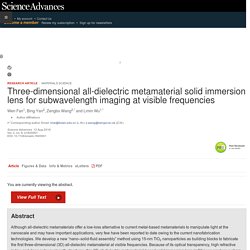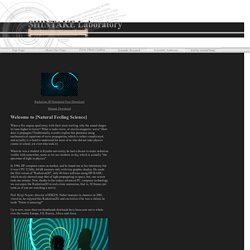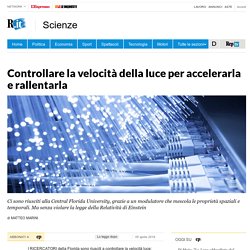

Mirages and Green Flash: Physclips - Light. The green flash When the horizon is distant, the setting sun often looks very red, because light from the sun passes through a long section of the atmosphere, so nearly all of the blue light and most of the green is scattered out.

Sometimes, for just a second or two, the very last visible part of the sun appears bright green. This is the green flash, which is due to both refaction (as are the mirages shown above) and scattering, which is responsible for the colours of the sky. The light from the sun bends towards the earth when it enters the atmosphere (at point c in the diagram), so that it is possible to see the sun even when the earth lies between the sun and the observer. Three-dimensional all-dielectric metamaterial solid immersion lens for subwavelength imaging at visible frequencies. Although all-dielectric metamaterials offer a low-loss alternative to current metal-based metamaterials to manipulate light at the nanoscale and may have important applications, very few have been reported to date owing to the current nanofabrication technologies.

We develop a new “nano–solid-fluid assembly” method using 15-nm TiO2 nanoparticles as building blocks to fabricate the first three-dimensional (3D) all-dielectric metamaterial at visible frequencies. Because of its optical transparency, high refractive index, and deep-subwavelength structures, this 3D all-dielectric metamaterial-based solid immersion lens (mSIL) can produce a sharp image with a super-resolution of at least 45 nm under a white-light optical microscope, significantly exceeding the classical diffraction limit and previous near-field imaging techniques.
KeywordsAll-dielectric metamaterialstitanium dioxideself-assembly, solid immersion lenssuper-resolution imagingCopyright © 2016, The Authors. Shintake Radiation2D. Radiation 2D Simulator Free Download Manual Download When a fire engine sped away with their siren wailing, why the sound chages its tone higher to lower?

What is radio wave, or electro-magnetic wave? How does it propagate? Traditionally, scientis explan this phenoma using mathematical equations of wave propagation, which is rather complicated, and actually it is hard to undersand for most of us who did not take physics course in school, (or even who took it). When he was a student in Kyushu university, he had a dream to make radiation visible with somewhat, same as we see rainbow in sky, which is actually "the spectrum of light in physics". In 1984, HP computer came on market, and he found one at his laboratory, but it was CPU 32 kHz, 64 kB memory only with tiny graphic display.
Prof. Quantum technology probes ultimate limits of vision. Israeli researchers develop infrared film for smartphones, self-driving cars. Researchers at Ben-Gurion University of the Negev say they have developed low-cost infrared sensors that can be used to create the world’s thinnest night-vision glasses as well as revolutionize smartphones and self-driving cars.

Prof. Gabby Sarusi, faculty member in the Unit of Electro-Optical Engineering and the Ilse Katz Institute for Nanoscale Science and Technology, has developed a stamp-like device of which one side reads 1,500-nanometer infrared wavelengths, and converts them to images that are visible to the human eye on the other side of the stamp. This stamp — basically a film that is half a micron in thickness — is composed of nano-metric layers, nano-columns and metal foil, which transform infrared images into visible images.
Get The Start-Up Israel's Daily Start-Up by email and never miss our top stories Free Sign Up The film can be put in front of normal glasses or telescopes, Sarusi said, transforming them into infrared devices. Controllare la velocità della luce per accelerarla e rallentarla. I RICERCATORI della Florida sono riusciti a controllare la velocità luce: l'hanno fatta accelerare fino a 30 volte e rallentare, utilizzando una nuova tecnica che non utilizza un mezzo intermedio attraverso la quale farla passare, come materiali e gas che ne rallentano la velocità.

Questa volta è tutto fatto nel vuoto e la tecnica si basa solo sul controllo del suo "spettro spazio temporale". Nessuna violazione della Relatività speciale di Einstein, niente può viaggiare più veloce della luce, nemmeno la luce. Questo effetto "superluminare", infatti, non comporta trasporto di informazione. La nuova tecnica è descritta in uno studio pubblicato sulla rivista Nature Communications da H. Esat Kondakci e Ayman F. Modificare la velocità della luce è un risultato già ottenuto più volte in laboratorio. L'approfondimento quotidiano lo trovi su Rep: editoriali, analisi, interviste e reportage. Saperne di più è una tua scelta Sostieni il giornalismo! Cina, nell'inverno più freddo lo spettacolo del "triplo sole" Che cosa ha causato lo spettacolare tramonto di ieri? 1.